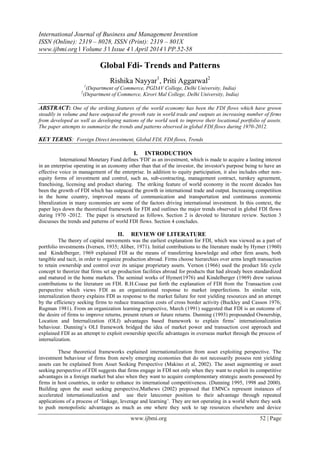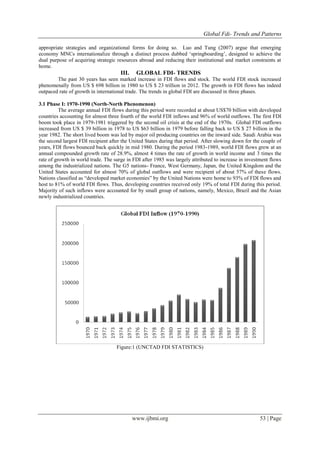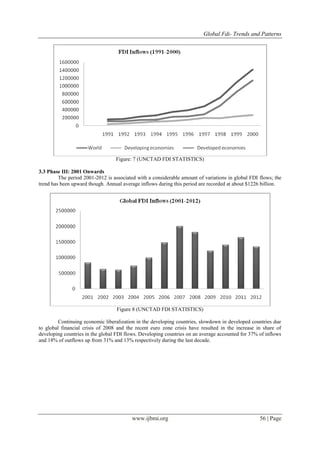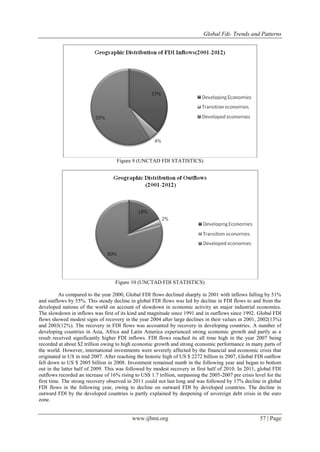The document analyzes global trends in foreign direct investment (FDI) from 1970 to 2012, highlighting its growth and the factors driving it, such as economic liberalization and competition. It identifies three distinct phases of FDI trends, noting a shift from developed to developing countries in FDI flows over time. The conclusion emphasizes the increasing significance of developing nations in global FDI dynamics and the impact of major economic crises on these trends.






![Global Fdi- Trends and Patterns
www.ijbmi.org 58 | Page
IV. CONCLUSION
The paper highlights the trend and patterns observed in Global FDIs which has been following an
upward trend since 1970s. In initial years, global FDI outflows and inflows were majorly driven by the
developed nations of the world indicating North-North phenomenon, where firms in advanced countries
invested in other advanced industrialized countries. US had been the most preferred investment destination.
However in the recent years and more particularly 2000 onwards share of developing countries in global FDI
flows have increased at a commendable pace. Various macroeconomic events ranging from Asian Financial
Crisis, Global Financial Crisis of 2008, euro zone crisis are responsible for the observed transformations in the
FDI flows. The increased share of developing countries in the global outflows and inflows reflects the growing
South-South phenomenon which can be expected to gain further momentum in the future.
REFERENCES
[1] Iversen, C. (1935) Aspects of International Capital Movements, (Levin and Munksgaard: London, Copenhagen).
[2] Aliber, R.Z. (1971) „The Multinational Enterprise in a Multi currency World‟, in J.H. Dunning (ed.) The MultinationalEnterprise,
(Allen and Unwin: London).
[3] Hymer, S.H. (1976). The International Operations of National Firms: A Study of Direct Foreign Investment, (Boston: MIT
Press).
[4] Kindelberger, C.P. (1969). American business abroad: six lectures on direct investment. (New Haven: Yale University Press).
[5] Vernon, R. (1966). „International investment and international trade in the product cycle‟, Quarterly Journal of Economics 80:
190-207.
[6] Buckley, P. J., & Casson, M.C. (1976). The Future of Multinational Enterprises, (London, Macmillan).
[7] Rugman, A. M. Inside the multinationals: the economics of internal markets( New York: Columbia University Press,1981)
[8] March, J.G. (1991). Exploitation and Exploration in Organizational Learning. Organization Science,2(1), 71-87.
[9] Makino,S, Lau, C.M, & Yeh, R.S. (2002). Asset Exploitation vs Asset seeking: Implications for location choice of foreign Direct
Investment from Newly Industrialised Economies. Journal of international Business Studies, 33(3), 403-421.
[10] Dunning, J. H. (1995). Re-appraising the Eclectic Paradigm in an Age of Alliance Capitalism, Journal of International Business
Studies, 26(3), 461-491.
[11] Dunning, J. H. (1998). Location and the Multinational Enterprise: A Neglected Factor?, Journal of International Business
Studies, 29(1), 45-66.
[12] Dunning, J. H. (2000).The Eclectic Paradigm as an Envelope for Economic and Business Theories of MNE Activity,
International Business Review, 9(2), 163- 190.
[13] Mathews, J.A., 2002. Dragon multinational: towards a new model of global growth.( Oxford University Press, New York).
[14] Luo, Y., Tung, R., 2007. International expansion of emerging market enterprises. Journal of International Business Studies 38
(4), 481–498.
[15] United Nations Conference on Trade and Development- (World Investment Reports (1995-2013). (New York and Geneva:
United Nations).
[16] Graham E.M. ,Krugman P.R, The Surge in Foreign Direct Investment in the 1980s, in Froot K.A (Ed.), Foreign Direct
Investment, (University of Chicago Press, 1992)13-36.](https://image.slidesharecdn.com/g0341052058-140512053609-phpapp01/85/G0341052058-7-320.jpg)